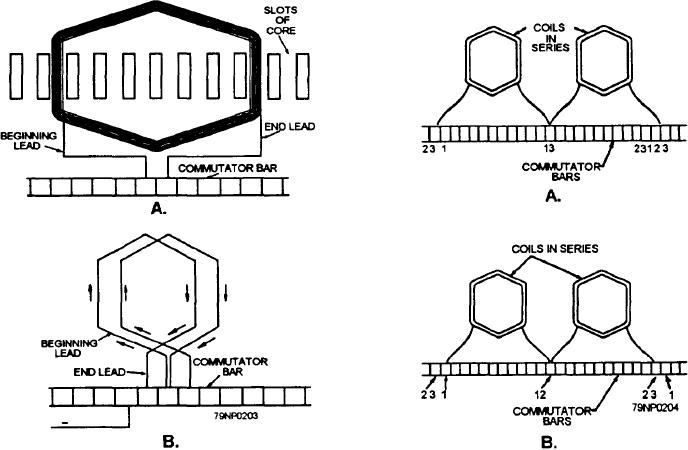
MULTIPLEX WINDINGS.-- Wmdings may also
7-30). This system helps to place the coils properly on
be classified and connected in SIMPLEX, DUPLEX, or
the armature.
TRIPLEX. A simplex lap winding is one in which the
PROGRESSIVE AND RETROGRESSIVE
beginning and ending leads of a lap-wound coil are
WINDINGS.-- Lap and wave windings can be
connected to adjacent commutator bars. Duplex and
progressive or retrogressive, as shown in figure 7-33.
triplex lap windings have their leads connected two or
Progressive Windings.-- A progressive winding
three bars apart, respectively.
(fig. 7-33, view A) progresses in a clockwise direction
Progressive and retrogressive simplex lap windings
around the armature when traced through the winding
are shown in figure 7-34. In the progressive lap
from the commutator end. In other words, the winding
winding, the current flowing in the coil terminates in the
progresses clockwise from segment (bar) through the
commutator bar clockwise, adjacent to the starting bar,
coil to segment.
as you view the armature from the commutator end. In
Progressive wave windings and retrogressive lap
a retrogressive simplex lap winding, the current in the
windings are very seldom encountered because of
coil terminates in the bar counterclockwise, adjacent to
inherent undesirable features, such as the end
the starting bar.
connections of coil groups crossing over each other,
Simplex progressive and retrogressive wave
added weight, and longer leads. Therefore, with few
windings are shown in figure 7-35. Compare these with
exceptions, lap windings are progressive and wave
the lap windings shown in figure 7-34.
windings are retrogressive.
TEST PROCEDURES. --Use of an organized test
Retrogressive Windings.-- A retrogressive
procedure will enable you to distinguish the types of
winding (fig. 7-33, view B) progresses in a
armature windings. One method is to use a low-reading
counterclockwise direction around the commutator
ohmmeter (capable of reading minute ohmic values) to
when traced through the winding from the commutator
indicate variations in the resistance reading as the test
end.
probes are shifted around on the commutator. If a
low-reading ohmmeter is not available, a milliammeter
Figure 7-35.--Four-pole simplex wave windings.
Figure 7-34.--Simplex lap windings.
7-27

